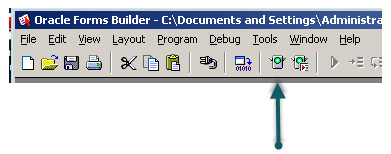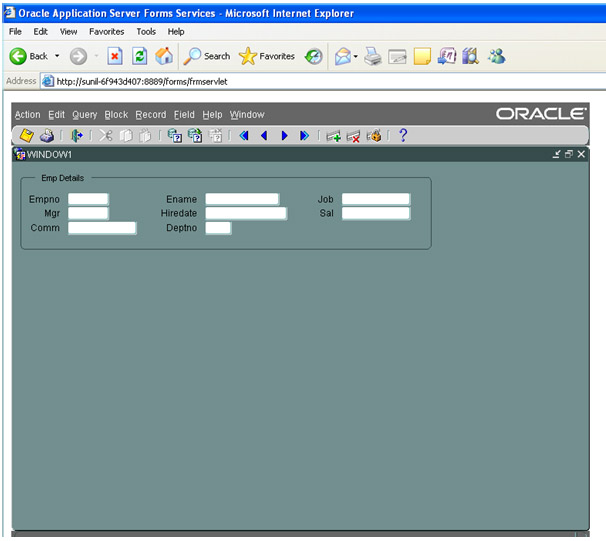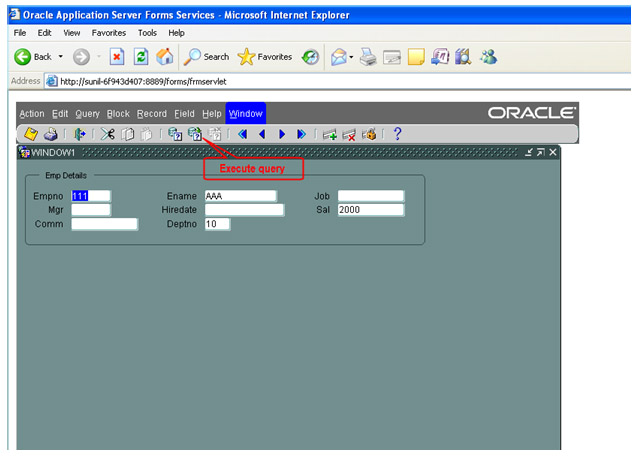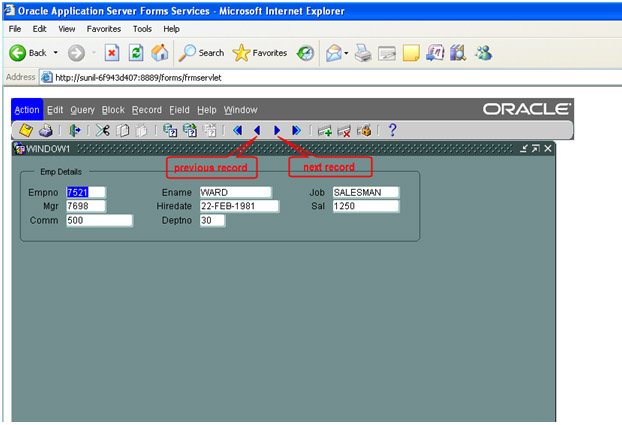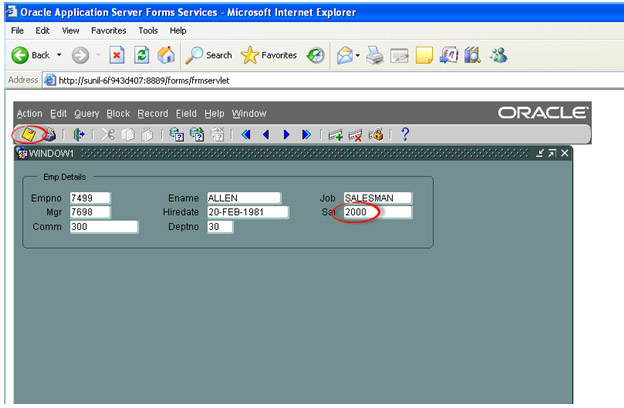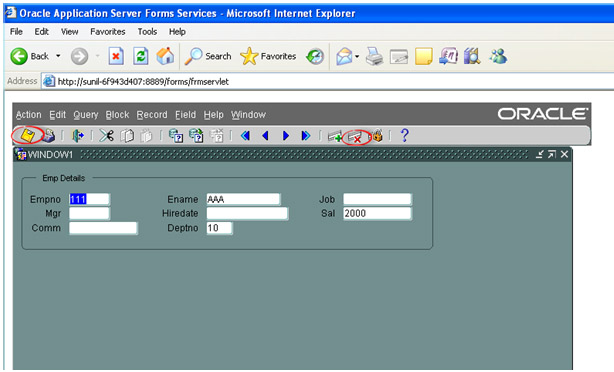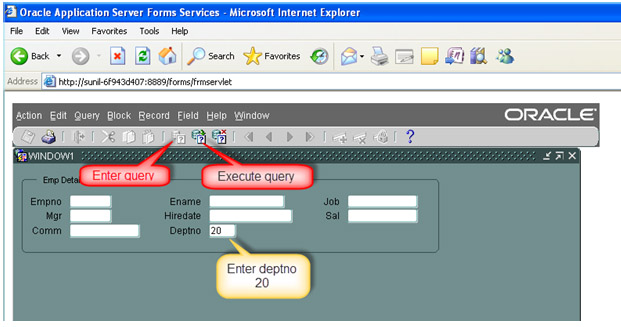SYSTEM.MOUSE_BUTTON_SHIFT_STATE : Indicates the key that was pressed during the click, such as SHIFT, ALT, or CONTROL. The value is always a character string.
SYSTEM.MOUSE_CANVAS : If the mouse is in a canvas, SYSTEM.MOUSE_CANVAS represents the name of that canvas as a CHARvalue. If the mouse is in an item, this variable represents the name of the canvas containing the item.
SYSTEM.MOUSE_CANVAS is NULL if:
• the mouse is not in a canvas
• the platform is non-GUI
SYSTEM.MOUSE_FORM : If the mouse is in a form module, SYSTEM.MOUSE_FORM represents the name of that form module as a CHAR value. For example, if the mouse is in Form_Module1, the value for SYSTEM.MOUSE_ITEM isFORM_MODULE1.
Note: SYSTEM.MOUSE_FORM is NULL if the platform is not a GUI platform.
SYSTEM.MOUSE_ITEM : If the mouse is in an item, SYSTEM.MOUSE_ITEM represents the name of that item as a CHAR value. For example, if the mouse is in Item1 in Block2, the value for SYSTEM.MOUSE_ITEM is :BLOCK2.ITEM1.
SYSTEM.MOUSE_ITEM is NULL if:
• the mouse is not in an item
• the platform is not a GUI platform
SYSTEM.MOUSE_RECORD : If the mouse is in a record, SYSTEM.MOUSE_RECORD represents that record's record number as aCHAR value.
Note: SYSTEM.MOUSE_RECORD is 0 if the mouse is not in an item (and thus, not in a record).
SYSTEM.MOUSE_RECORD_OFFSET : If the mouse is in a record, SYSTEM.MOUSE_RECORD_OFFSET represents the offset from the first visible record as a CHAR value.
For example, if the mouse is in the second of five visible records in a multi-record block,SYSTEM.MOUSE_RECORD_OFFSET is 2. (SYSTEM.MOUSE_RECORD_OFFSET uses a 1-based index).
Note: SYSTEM.MOUSE_RECORD_OFFSET is 0 if the mouse is not in an item (and thus, not in a record).
SYSTEM.MOUSE_X_POS : Represents (as a CHAR value) the x coordinate of the mouse in the units of the current form coordinate system. If the mouse is in an item, the value is relative to the upper left corner of the item's bounding box. If the mouse is on a canvas, the value is relative to the upper left corner of the canvas.
Note: SYSTEM.MOUSE_X_POS is always NULL on character mode platforms.
SYSTEM.MOUSE_Y_POS : Represents (as a CHAR value) the y coordinate of the mouse, using units of the current coordinate system. If the mouse is in an item, the value is relative to the upper left corner of the item's bounding box. If the mouse is on a canvas, the value is relative to the upper left corner of the canvas.
Note: SYSTEM.MOUSE_Y_POS is always NULL on character mode platforms.
SYSTEM.RECORD_STATUS : Represents the status of the record where the cursor is located. The value can be one of four character strings:
• CHANGED - Indicates that a queried record's validation status is Changed.
• INSERT - Indicates that the record's validation status is Changed and that the record does not exist in the database.
• NEW - Indicates that the record's validation status is New.
• QUERY - Indicates that the record's validation status is Valid and that it was retrieved from the database.
SYSTEM.SUPPRESS_WORKING* : suppresses the "Working..." message in Runform, in order to prevent the screen update usually caused by the display of the "Working..." message. The value of the variable is one of the following two CHARvalues:
• TRUE - Prevents Oracle Forms from issuing the "Working..." message.
• FALSE - Allows Oracle Forms to continue to issue the "Working..." message.
SYSTEM.TRIGGER_BLOCK : Represents the name of the block where the cursor was located when the current trigger initially fired. The value is NULL if the current trigger is a Pre- or Post-Form trigger. The value is always a character string.
SYSTEM.TRIGGER_ITEM : Represents the item (BLOCK.ITEM) in the scope for which the trigger is currently firing. When referenced in a key trigger, it represents the item where the cursor was located when the trigger began. The value is always a character string.
SYSTEM.TRIGGER_RECORD : Represents the number of the record that Oracle Forms is processing. This number represents the record's current physical order in the block's list of records. The value is always a character string.
All system variables, except the four indicated with an asterisk (*), are read-only variables. These four variables are the only system variables to which you can explicitly assign values.
Date and Time System Default Values
Oracle Forms also supplies six special default values -- $$DATE$$, $$DATETIME$$, $$TIME$$, $$DBDATE$$, $$DBDATETIME$$, and $$DBTIME$$ -- that supply date and time information and have special restrictions on their use:
• If you're building client/server applications, consider the performance implications of going across the network to get date and time information.
• If you're accessing a non-ORACLE datasource, avoid using $$DBDATE$$ and$$DBDATETIME$$. Instead, use a When-Create-Record trigger to select the current date in a datasource-specific manner.
• Use $$DATE$$, $$DATETIME$$, and $$TIME$$ to obtain the local system date/time; use$$DBDATE$$, $$DBDATETIME$$, and $$DBTIME$$ to obtain the database date/time, which may differ from the local system date/time if, for example, you're connecting to a remote database in a different time zone.
• Use these variables only to set the value of the Default Value, Range Low Value or Range High Value property.
$$DATE$$ : Retrieves the current operating system date. You can use $$DATE$$ to designate a default value or range for a text item using the Default or Range property. The text item must be of the CHAR, DATE, or DATETIME data type. You also can use $$DATE$$ as a default value for form parameters. In this case, the parameter's value is computed once, at form startup.
$$DATETIME$$ : Retrieves the current operating system date and time. You can use $$DATETIME$$ to designate a default value or range for a text item using the Default or Range property. The text item must be of the CHAR or DATETIME data type. You also can use $$DATETIME$$ as a default value for form parameters. In this case, the parameter's value is computed once, at form startup.
The difference between $$DATE$$ and $$DATETIME$$ is that the time component for $$DATE$$is always fixed to 00:00:00, compared to $$DATETIME$$, which includes a meaningful time component, such as 09:17:59.
Note: Do not use $$DATETIME$$ instead of $$DATE$$ unless you plan to specify the time component. If, for example, you use $$DATETIME$$ with the default DATE format mask of DD-MON-YY, you would be committing values to the database that the user would not see, because the format mask does not include a time component. Then, because you had committed specific time information, when you later queried on date, the values would not match and you would not return any rows.
$$DBDATE$$ : Retrieves the current database date. You can use $$DBDATE$$ to designate a default value or range for a text item using the Default or Range property. The text item must be of the CHAR, DATE, orDATETIME data type.
$$DBDATETIME$$ : Retrieves the current date and time from the local database. You can use $$DBDATETIME$$ to designate a default value or range for a text item using the Default or Range property. The text item must be of the CHAR or DATETIME data type.
$$DBTIME$$ : Retrieves the current time from the local database. You can use $$DBTIME$$ to designate a default value or range for a text item using the Default or Range property. The text item must be of the CHAR orTIME data type.
$$TIME$$ : Retrieves the current operating system time. You can use $$TIME$$ to designate a default value or range for a text item using the Default or Range property. The text item must be of the CHAR or TIMEdata type.
You also can use $$TIME$$ as a default value for form parameters. In this case, the parameter's value is computed once, at form startup.
Local Variables
Because system variables are derived, if the value is not expected to change over the life of the trigger, you can save the system value in a local variable and use the local variable multiple times.

































